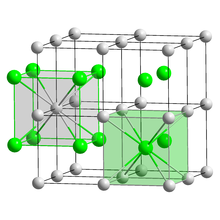Sodium–potassium alloy

| |
| Identifiers | |
|---|---|
| ECHA InfoCard | 100.112.643 |
CompTox Dashboard (EPA)
|
|
| Properties | |
| Na + K | |
| Molar mass | N/A |
| Appearance | Liquid metal |
| Density | 0.855 g/mL at 100°C |
| Melting point | -11°C (12°F) [1] |
| Boiling point | 785°C (1445°F) |
| Reacts violently | |
| Thermal conductivity | 23 W·m−1·K−1[2] |
| Hazards | |
| Occupational safety and health (OHS/OSH): | |
Main hazards
|
Highly Reactive, Corrosive and Flammable |
Except where otherwise noted, data are given for materials in their standard state (at 25 °C [77 °F], 100 kPa).
| |
NaK, or sodium-potassium alloy, an alloy of potassium (K) and sodium (Na), is usually liquid at room temperature.[3] Various commercial grades are available. NaK is highly reactive with water and may catch fire when exposed to air, so must be handled with special precautions. Quantities as small as one gram can be a fire or explosion risk.[1]
Physical properties
NaK containing 40% to 90% potassium by weight is liquid at room temperature. The eutectic mixture consists of 78% potassium and 22% sodium, is liquid from −12.6 to 785°C, and has a density of 866 kg/m³ at 21°C and 855 kg/m³ at 100°C, making it less dense than water.[3] It reacts explosively with water and is stored under dry nitrogen (or, even better, dry argon) for safety reasons.[4]
When stored in air, it forms a yellow potassium superoxide coating and may ignite. This superoxide reacts explosively with organics. NaK is not dense enough to sink in most hydrocarbons, but will sink in lighter mineral oil. It is unsafe to store in this manner if the superoxide has formed. A large explosion took place at the Oak Ridge Y-12 facility on December 8, 1999, when NaK cleaned up after an accidental spill and inappropriately treated with mineral oil was scratched with a metal tool.[5] It also attacks Teflon.
NaK has a very high surface tension, which makes large amounts of it pull into a bun-like shape. Its specific heat capacity is 982 J/(kg.K), which is roughly one-fourth of that for water.[2]
![Solid-liquid phase diagram of sodium and potassium[6]](http://upload.wikimedia.org/wikipedia/commons/thumb/5/54/Phase_diagram_potassium_sodium_s_l.svg/310px-Phase_diagram_potassium_sodium_s_l.svg.png)
-
NaK alloy is liquid at room temperature.
Usage
Coolant
NaK has been used as the coolant in experimental fast neutron nuclear reactors. Unlike commercial plants, these are frequently shut down and defuelled. Use of lead or pure sodium, the other materials used in practical reactors, would require continual heating to maintain the coolant as a liquid. Use of NaK overcomes this.
The Soviet RORSAT radar satellites were powered by a NaK-cooled reactor.[7][8] As well as the wide liquid temperature range, NaK has a very low vapor pressure, which is important in the vacuum of space.
The Danish computer cooling company Danamics use NaK in their CPU coolers.[9]
Desiccant
Both sodium and potassium are used as desiccants in drying solvents prior to distillation.
Synthesis and production
Industrially, NaK is produced in a reactive distillation.[10] In this continuous process, a distillation column is fed with potassium chloride and sodium. In the reaction zone, potassium chloride reacts with sodium to form sodium chloride and potassium. The lighter, boiling potassium is enriched in an upper fractionating zone and drawn at the column head while sodium chloride is withdrawn from the bottom.
References
- ^ a b "Material Safety Data Sheet" (PDF). youngshin.com/../NaK-MSDS.pdf 2009-05-19
- ^ a b "Danamics LM10 - Liquid metal put to the test".
{{cite web}}: Unknown parameter|unused_data=ignored (help) 2010-01-10 nordichardware.com - ^ a b "Sodium-Potassium Alloy (NaK)" (PDF). BASF. Retrieved 2009-03-05.[dead link]
- ^ Strem Chemical. "MSDS". Retrieved 4 April 2012.
- ^ Oak Ridge Explosion U.S. Department of Energy[dead link]
- ^ G.L.C.M. van Rossen, H. van Bleiswijk: Über das Zustandsdiagramm der Kalium-Natriumlegierungen, in: Z. Anorg. Chem., 1912, 74, S. 152–156.
- ^ Space.com article about RORSATs leaking NaK after jettisoning their reactor core. Retrieved 03/10/2009.[dead link]
- ^ Klinkrad, Heiner (2006-02-23). Space debris: models and risk analysis. p. 83. ISBN 978-3-540-25448-5.
- ^ Danamics Liquid Metal Technology Retrieved 10/28/2009.[dead link]
- ^ Jackson, C. B.; Werner, R. C. (1957-01-01). "The Manufacture of Potassium and NaK". Advances in Chemistry. 19: 169–173. doi:10.1021/ba-1957-0019.ch018. ISBN 978-0-8412-0020-3.
{{cite journal}}:|chapter=ignored (help); Unknown parameter|eisbn=ignored (help)

